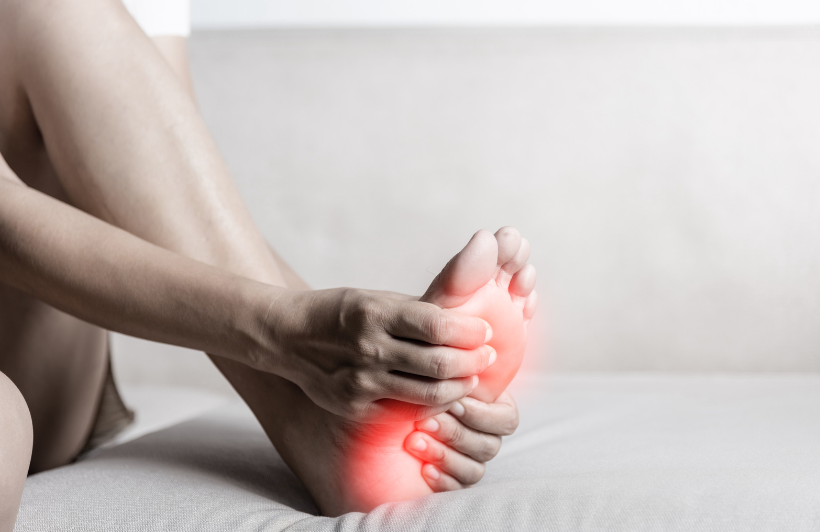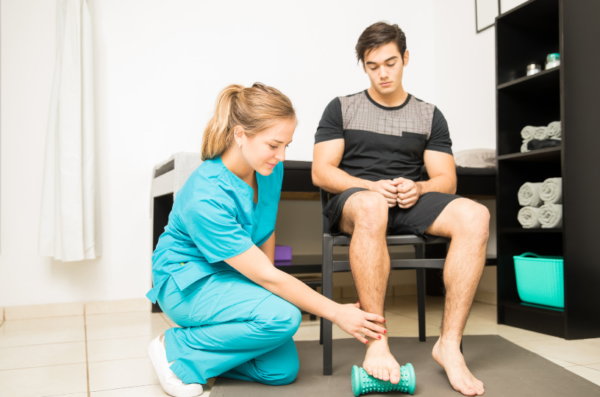How To Cure Plantar Fasciitis in One Week. Plantar fasciitis, or heel pain, is a frequent ailment. The plantar fascia is a band of tissue that links your heel to your toes and supports your foot’s arch. This tissue can become irritated and produce heel discomfort.
Plantar fasciitis is frequently caused by overuse, such as prolonged jogging or standing. Wearing shoes that do not support the arch of your foot or having tight calf muscles might also contribute to it. There are various things you may do to assist ease the discomfort and speed up the healing process of plantar fasciitis. One of them, you can improve circulation in the legs while sleeping, to get better comfort and less pain.
In this article, we will dive in on how to cure plantar fasciitis in one week and give you the best tips and strategies to get better as fast as possible from plantar fasciitis. To begin, rest your foot as much as possible and avoid activities that exacerbate the discomfort. Second, to minimize inflammation, ice your heel for 20 minutes multiple times a day. Third, stretch your calf muscles and Achilles tendon daily to relieve any tension. Finally, put on a supportive shoe or insert to relieve strain on your heel. Plantar fasciitis will heal in one to two weeks with moderate care and patience.
However, if the discomfort does not lessen after two weeks or worsens, consult your doctor for additional assessment.
Read More: How To Improve Diffusion Capacity
What is plantar fasciitis and what are the symptoms

Plantar fasciitis is an inflammation of the plantar fascia, which links the heel to the toes. It’s a rather frequent ailment that can result in heel discomfort and stiffness. Sharp pain in the heel, discomfort when walking, or pain after resting are all symptoms.
It is typical to have substantial discomfort upon getting out of bed in the morning or after a period of rest and standing. So now you have an idea and understanding of how to cure plantar fasciitis in one week. The discomfort usually goes away after a few minutes; but, as the day goes on, especially with increasing activity, the pain level might rise.
How to cure plantar fasciitis in one week

This is feasible if discovered early. Activity modification or limitation is the most crucial treatment to undertake. At the end of the day, if you are preparing for a marathon and are experiencing extreme pain in your heel, you will either continue with your training plan or the discomfort will worsen.
This will just make the rehabilitation process more difficult. Ice, compression, elevation, orthotics, anti-inflammatories like Tylenol, and massage are some of the other more typical therapy techniques. One popular method is to freeze a water bottle and then roll it beneath the foot.
This will provide cryotherapy as well as massage at the same time. By understanding terms, you can get closer to your quest on how to cure plantar fasciitis in one week.
Read More: How Accurate are Biological Age Tests?
The Best Exercises for Plantar Fasciitis

- A tight calf muscle is highly frequent with plantar fasciitis, as well as other foot and ankle diseases.
- Stretching the calf muscle is particularly useful for reducing stress in the arch.
- One of the finest techniques to stretch the calf muscles is to place the foot against a wall while keeping the knee straight and not bent.
- With a straight back and forward gaze, bring the torso/upper body towards the wall, and a stretch at the back of the calf muscle should be felt.
- Holding the stretch for 15 to 20 seconds three to four times a day will be quite useful.
- Stretching the calf with a belt or Thera-Band in bed before taking the first step in the morning can also be extremely useful.
- Although the discomfort may not be totally relieved, it will most likely be more manageable than not stretching.
- Stretching the fascia can also be beneficial.
- This is accomplished by placing the afflicted foot on your opposite knee.
- The toes are then pressed upward with your hand, a movement known as dorsiflexion.
- Because the plantar fascia is linked to all of your toes, bending your toes up will cause the fascia to stretch.
- Hold for 15 to 20 seconds and repeat 3-4 times each day.
The importance of wearing supportive shoes
Walking barefoot, in flip-flops, or in anything without support just adds to the strain and tension on the plantar fascia. It is critical to wear supportive, non-flexible footwear. This will safeguard the fascia and allow it to heal properly.
5 Best Shoes for Plantar Fasciitis, According to Experts
We asked physical therapists and podiatrists about the best shoes for plantar fasciitis (including sneakers and gym shoes, dress shoes, sandals, and slippers), as well as detachable insole tips, to make any shoe more plantar fasciitis friendly.
Best Running Shoes for Plantar Fasciitis
it is recognized for producing “maximalist” shoes (imagine big pairs with thick, outsize soles) that stand in sharp contrast to the many minimalist variants available. Hoka shoes are an excellent solution for persons suffering from plantar fasciitis due to their increased cushioning.
And the Bondi line, in particular, is one of the finest running shoes for plantar fasciitis patients since they’re broad and lightweight while still being well cushioned. SELF speaks with Bianca Beldini, DPT, a physical therapist, the creator of Sundala Wellness, and a USA Triathlon Level One coach in New York City.
• Sizes: US 7 to 16
• Width: regular, wide, and extra wide
Best Walking Shoes for Plantar Fasciitis
Hoka shoes include deep heel counters and the trademark cloudlike cushioning that makes your heels feel “hugged.” Because of their tight, plush fit, they are among the finest walking shoes for persons with plantar fasciitis.
The Clifton is recommended for walking by Dr. Gamez because of its responsive midsole, which helps send energy into your feet and legs while you walk. The Clifton 9, the latest iteration in this range, helped relieve SELF’s executive editor’s plantar fasciitis discomfort and sealed its spot as her new go-to trainer.
• Sizes: US 5 to 12
• Width: regular and wide
Best Hiking Boots for Plantar Fasciitis
Keen Targhee II Mid-Hiking Boots
The Keen Targhee II is a popular hiking boot, with over 2,000 five-star ratings on Amazon—and it’s especially popular among outdoor enthusiasts with plantar fasciitis, owing to its cushioned, supportive construction.
“I just got back from a nine-day walk in the West… I have plantar fasciitis in one foot.” “These were the most comfortable shoes I’ve ever owned,” remarked one Amazon reviewer.
• Sizes: US 5 to 11
• Width: Regular
Best Sandals for Plantar Fasciitis
According to Theresa Marko, PT, DPT, MS, owner of Marko Physical Therapy, this sports sandal is comfy, has arch support, and is easy to clean.
According to Dr. Marko, the strapping system over the top of the foot and across the back of the heel is adjustable for a more secure fit, so your ankle stays secure and your foot comfortable even after walking longer distances.
Unlike traditional flip-flops, which require your foot to grip in order to keep the shoe on, the Teva Verra employs a backstrap to hold your foot comfortably in position within the shoe, according to Dr. Marko.
• Sizes: US 5 to 11
• Width: medium
Best Dress Shoes for Plantar Fasciitis
Here’s an example of a dressier shoe that avoids the hazards of most flats, which can aggravate people’s plantar fasciitis in general: According to Eby, it boasts a half-inch heel drop, an elastic band across the instep to secure the shoe on your foot, and a cushioned insole with mild arch support.
These shoes are lightweight, available in two widths, and reasonably priced.
• Sizes: US 6.5 to 12
• Width: medium and wide
Read More: Self Car Wash: How To Use it
Plantar Fasciitis Inserts, The Best of the Home Remedies for Plantar Fasciitis?
- Rest and Ice Therapy: Give your feet ample rest and apply ice packs for 15-20 minutes several times a day to reduce inflammation.
- Stretching Exercises: Perform gentle stretching exercises that target the calves, Achilles tendon, and plantar fascia to improve flexibility and relieve pain.
- Supportive Footwear: Wear shoes with proper arch support and cushioning to alleviate pressure on the plantar fascia.
- Night Splints: Utilize night splints that keep your foot and calf in a stretched position while you sleep, promoting healing and reducing morning pain.
Non-Invasive Treatments
In addition to home remedies, several non-invasive treatments can aid in the recovery from plantar fasciitis in one week. These treatments are typically recommended for persistent or severe cases and may include:
- Physical Therapy: Under the guidance of a physical therapist, specific exercises and techniques can help improve strength, flexibility, and overall foot function.
- Orthotics and Arch Supports: Custom-made orthotic inserts or over-the-counter arch supports can provide additional support and relieve pressure on the plantar fascia.
- Extracorporeal Shock Wave Therapy (ESWT): This non-invasive procedure involves delivering shock waves to the affected area to stimulate healing and reduce pain.
Natural Remedies and Supplements
While not scientifically proven, some natural remedies and supplements may complement your treatment plan and aid in pain relief in one week. These include:
- Epsom Salt Soaks: Soaking your feet in warm water with Epsom salts can help reduce inflammation and ease discomfort.
- Turmeric and Ginger: These natural anti-inflammatory agents can be consumed orally or applied topically to help reduce pain and swelling.
- Fish Oil and Omega-3 Fatty Acids: These supplements possess anti-inflammatory properties that may assist in managing plantar fasciitis symptoms.
Pain Management Technique
Over-the-counter pain medications such as ibuprofen or acetaminophen can give brief relief in circumstances when discomfort continues.
Topical analgesics, such as creams or gels, can also be administered directly to the afflicted region to relieve pain and decrease inflammation.
Lifestyle Changes for Faster Recovery
Certain lifestyle adjustments can facilitate quicker recovery from plantar fasciitis. Consider the following:
- Weight Management: Maintaining a healthy weight can reduce the strain on your feet, promoting faster healing.
- Low-Impact Exercises: Engage in low-impact activities like swimming or cycling to stay active while minimizing stress on the plantar fascia.
- Proper Foot Care: Practice good foot hygiene, wear appropriate footwear, and avoid walking barefoot on hard surfaces to prevent further aggravation.
Prevention Strategies to cure plantar fasciitis
Preventing plantar fasciitis is essential to avoid recurrent pain. Follow these strategies to minimize the risk:
- Footwear Selection: Choose shoes that provide adequate arch support, cushioning, and shock absorption.
- Regular Stretching and Strengthening Exercises: Incorporate stretching and strengthening exercises into your routine to keep the plantar fascia flexible and resilient.
- Gradual Increase in Physical Activity: If you’re starting a new exercise program, increase intensity and duration gradually to prevent overloading the feet and causing strain.
When to Consider Surgery
Maybe you have an option for your problem How To Cure Plantar Fasciitis in One Week to solve it fast by surgery. We may consider surgery in extreme situations if conservative therapies have failed to relieve symptoms.
Plantar fascia release, which includes partly cutting the plantar fascia to reduce stress and facilitate healing, is one surgical approach for plantar fasciitis.
Additional tips and advice
Plantar fasciitis is not always the source of heel discomfort. If symptoms persist, it is suggested that you see a skilled foot and ankle practitioner.
Heel discomfort can also be caused by a stress fracture, infection, bone tumor, or nerve entrapment, among other things. A comprehensive history and physical examination are required to properly diagnose this.
Conclusion
In conclusion, for our guide on how to cure plantar fasciitis in one week. Plantar fasciitis can have a substantial impact on your everyday life, but with appropriate care and treatment, you can reduce discomfort and speed healing.
You may easily heal plantar fasciitis in one week or lessen the discomfort over time by using a complete strategy that includes home cures, non-invasive therapies, natural remedies, pain management techniques, lifestyle adjustments, and preventative tactics.
FAQs
A podiatrist can assess your foot type and suggest suitable footwear or advise you on preventing discomfort sources.
A tight calf muscle and fascia can be stretched to assist in the release of tension.
Keep a healthy weight. Your plantar fasciitis may be under more strain if you are heavier
Select supportive footwear.
Purchase footwear with a low to moderate heel, thick soles, substantial arch support, and additional padding
Avoid sporting worn-out athletic sneakers
Change your sport
Apply some ice
As soon as you begin treating your plantar fasciitis, you should notice an improvement in your symptoms.
However, the time it takes for your plantar fascia to heal might range from weeks to months.
Try the same at-home remedies you previously used if you start to feel better, but then your symptoms come back.
Plantar fasciitis typically gets better after a few months of stretching.
However, injections o reduce inflammation may be suggested by your doctor if your symptoms persist after two months of treatment.

